BC Employment and Assistance
The goal of the BC Employment and Assistance (BCEA)
program is to assist people who are able to work in achieving
sustainable employment while providing income assistance to
those most in need.
BCEA provides services to both temporary assistance and disability
assistance clients.
Temporary assistance clients include those that are expected
to work and have employment related obligations, those who
are temporarily excused from work and persons with persistent
multiple barriers.
Disability assistance is available to eligible persons with
disabilities who may not achieve complete financial independence
through employment.
The Ministry of Human Resources' employment programs support
temporary assistance and disability assistance clients as
they move toward self-reliance.
Caseload trends
From 1994/95 to 2003/04, the annual average income assistance
caseload decreased from 210,492 to a forecasted 116,700, a
reduction of 44.9 per cent. The caseload is expected
to continue to decline over the next three years to an estimated
108,700 in 2004/05, 107,800 in 2005/06 and 106,100 in 2006/07.
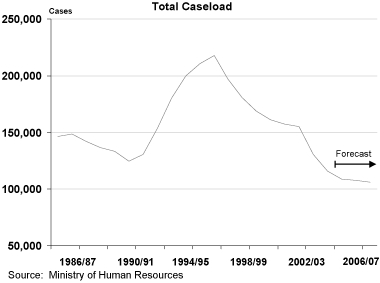
For 2003/04, temporary assistance is estimated to be 57 per cent
of the caseload, including 29 per cent of the caseload
expected to work, 20 per cent temporarily excused
from work and 8 per cent persons with persistent
multiple barriers. Persons with disabilities make up the remaining
43 per cent of the caseload.
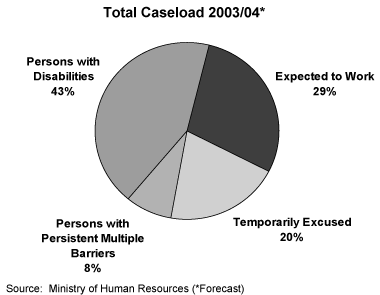
Expectation to actively seek employment
Employable clients are required to have an active employment
plan as a condition of eligibility for income assistance.
Employment plans outline the ministry's expectations of clients
regarding their activities that will lead to employment. This
may include directed job search, referral to job placement
programs and specific training for employment, which provide
clients with access to the tools and supports they require
to find a job and become independent of income assistance.
Employment Programs
Employment programs are available to assist clients to find
and sustain employment and include the Job Placement and Training
for Jobs programs. Specialized employment programs under the
Employment Strategy for Persons with Disabilities are available
to support persons with disabilities.
The provincial government spent $300 million over three
years (from 2001/02 to 2003/04) on employment programs. In
2004/05, due to the declining number of employable clients,
government will spend less on employment programs.
Expected to Work Clients
In the last five years, the caseload for those expected to
work has fallen from 104,040 in 1998/99 to an estimated 33,140
in 2003/04, a decline of 70,900 or 68.1 per cent.
This caseload is expected to continue to decline at a modest
rate over the next three years.
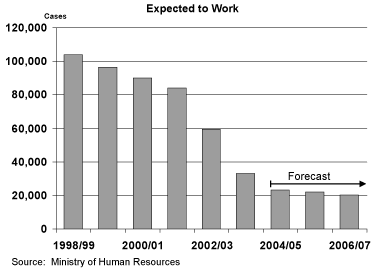
Since June 2001, more than 26,000 income assistance
clients have been placed in jobs through ministry contracted
job placement agencies. The majority of jobs are in the retail
sales, hospitality and service occupations, office administration,
manufacturing and trades related areas. This is consistent
with the results of the ministry's client exit surveys. To
date, the average wage for participants in the Training for
Jobs program is $9.36 per hour and $10.29 per hour
for the Job Placement program.
Temporarily Excused
Temporarily Excused clients are those that are temporarily
excused from employment plan obligations, such as parents
of a young child and those with a temporary illness or injury
that prevents the person from working and requires medical
treatment. These clients receive the same rate as clients
that are expected to work. The temporarily excused category
is expected to decline at a moderate rate over the next three
years.
Persons with Persistent Multiple Barriers (PPMB)
The PPMB category was created in September 2002 to recognize
people who may be unable to achieve financial independence
because of persistent multiple barriers to employment that
are beyond the person's control. PPMB clients receive a higher
rate of assistance than those who are expected to work. At
the end of 2003, there were 11,480 PPMB cases. This number
is expected to rise at a modest rate as the provincial population
increases and ages.
Persons with Disabilities (PWD)
The Employment and Assistance for Persons with Disabilities
Act recognizes that people with disabilities face unique
challenges in daily living and may require ongoing assistance
or supports to employment.
The PWD caseload has more than tripled in twenty years, from
15,840 in 1984/85 to an estimated 49,699 in 2003/04. The PWD
caseload is expected to grow by approximately 5 per cent
in 2004/05 and to rise to an estimated 56,400 in 2006/07 as
the provincial population increases and ages.
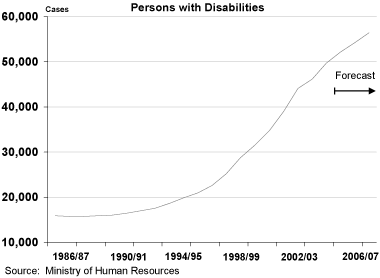
Caseload Distribution
As the temporary assistance caseload declines and the disability
assistance caseload increases, the percentage of the total
caseload receiving disability assistance is expected to climb
to over 50 per cent by 2006/07. Given the change
in the proportion of disability assistance cases to temporary
assistance cases, the overall average cost per BCEA case will
increase reflecting the higher rate of assistance provided
to persons with disabilities.
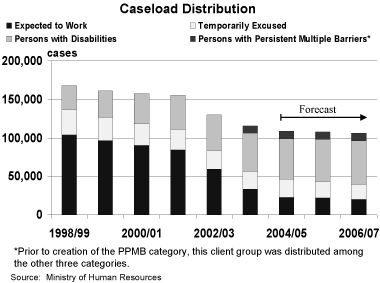
Beginning in 2004/05, an additional $80 million was
added to the Ministry of Human Resources' budget to accommodate:
- a more modest rate of temporary assistance caseload decline
than previously estimated and
- a higher rate of growth for the disability assistance
caseload than previously estimated.
Time Limits
The BC Employment and Assistance program encourages
personal responsibility, emphasizing self-reliance through
employment. Under the Employment and Assistance Act,
temporary assistance recipients are expected to look for and
accept employment. In order to further support a system based
upon personal responsibility, the ministry established time
limits for those able to work. This policy limits access to
income assistance to a maximum of 24 out of 60 months, and
encourages clients to take advantage of all opportunities
that lead to employment.
There are 25 exemptions to the time limit policy. These include
persons with disabilities, persons with persistent multiple
barriers, pregnant women, and parents with children under
the age of three. In addition, people with a mental illness,
drug or alcohol problems, or other barriers are exempt where
the condition interferes with their ability to search for,
accept or continue in employment. People who exceed their
time limit and continue to be compliant with their Employment
Plan will not be affected by time limits. For a complete list
of categories that are exempt as part of the time limits policy,
please refer to the ministry's website (www.mhr.gov.bc.ca).
Conclusion
The Ministry of Human Resources will continue to:
- work with employable people to support them in their efforts
to gain employment and self-reliance;
- assist persons with disabilities to achieve greater independence,
whether in their daily life or in the workplace, while ensuring
that those who are unable to work are provided with the
assistance they need; and
- work towards increasing public confidence that taxpayer
dollars are being directed only to those most in need.
|
